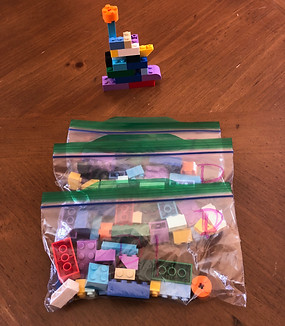Lego Model Challenge
Estimated Time Required: 30 - 45 minutes
Themes: spatial IQ, problem solving, communication
Learning Points
-
Spatial intelligence is used to visualize a solution in your mind
-
Efficiency comes from examining and improving processes
Materials
-
A set of LEGO® bricks
-
Sealable baggies
-
Paper
-
Pen/Marker

This activity challenges participants to reconstruct a 3D model of LEGO® bricks from memory. To place each block correctly each team must remember the brick's color, block dimensions (length, width, and height), and how it relates to the pieces around it. We're so used to living in an online 2D world that these visualization skills are often neglected, even though these skills can help us solve abstract problems. The good news is that you can strengthen your skills by doing things as simple as playing with LEGO bricks.
Before the event
-
Determine the number of 3-to-4 person teams.
-
Construct a LEGO model using around 20 bricks.
-
Organize the LEGO bricks so that each team will
have the same set of LEGO bricks that you used
to make the model and store each set in a plastic
baggie. If you have many teams and don’t have
enough of the same bricks for all of your teams,
you can construct more models with matching team
LEGO sets. Label each model with a letter
and each team LEGO bag with the(i.e. A, B, C, etc.)same letter.
-
Take a picture of each side of the model.
Event Setup
-
Each team should have their own table with one of the LEGO sets on it.
-
Place the LEGO model(s) in a spot that is hidden from view from the team tables. Ideally, people viewing the models shouldn't be able to see their team. One method for handling this is to place the models on a table in the hall instead of in the classroom.
-
If you are using more than one LEGO model, you will need to label each LEGO model with its corresponding model letter, so that the teams know which model to build.
-
Instruct your students to form teams of 3 to 4 people and sit at one of the tables with a LEGO set.
-
Be the first team to recreate the LEGO model assigned to your team.
-
Teams can only use the LEGO set given to them to create their model. No other tools or materials, including phones, cameras, paper, etc, can be used.
-
Have each team designate a team member to be the first viewer.
-
When the challenge starts, the team viewers will go to the LEGO model with their letter on it (A, B, C, etc).
-
The viewer will try to memorize as much of the model as they can. The viewer can't communicate with their team in any way while they're viewing the model.
-
The viewer will return to their team and instruct their team on how to build the model without touching the bricks themselves.
-
When the team has gone as far as they can, the team will nominate a different person to be the viewer. The same person can’t be the viewer two times in a row.
-
The game will continue in this pattern until a team successfully duplicates the original sculpture.
Note: The pictures of the model can be used in case the model gets broken while playing or to help verify the results when a team thinks they're done.
-
Discuss the strategies that were used and their effectiveness.
-
Are there any rules that need to be updated or added?
-
What are the most important skills that are needed to be successful in the game?
-
Discuss spatial intelligence and ways to develop it.
-
Discuss how spatial intelligence could be used in the real world.
Intro
Preparation
What To Do
Discuss
